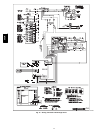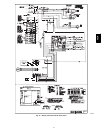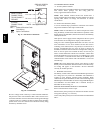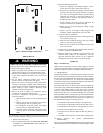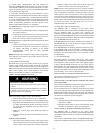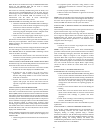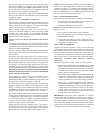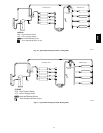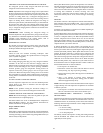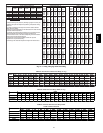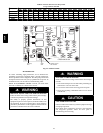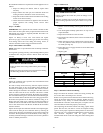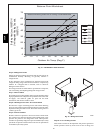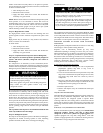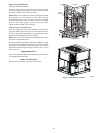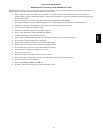
22
CHECKING AND ADJUSTING REFRIGERANT CHARGE
The refrigerant system is fully charged with Puron (R-- 410A)
refrigerant and is tested and factory sealed.
NOTE: Adjustment oftherefrigerant chargeisnot required unless
theunitissuspected of nothaving the proper R--410A charge. The
charginglabelandthetablesshownrefertosystemtemperaturesand
pressures in cooling mode only. A refrigerant charging label is
attached to the outside of the service access door. If charge level is
suspect in heating mode, reclaim all refrigerant and charge to
informativeplateamount. (Thisinformation maybe obtainedfrom
the physical data table also.) The charging label and the tables
shown referto system temperatures and pressures in cooling mode
only. A refrigerant charging label is attached to the outside of the
service access door.
IMPORTANT: When evaluating the refrigerant charge, an
indicated adjustment to thespecified factory chargemust alwaysbe
very minimal.Ifa substantialadjustment is indicated, an abnormal
condition exists somewhere in the cooling system, such as
insuf ficient airflow across either coil or both coils.
REFRIGERANT CHARGE
The amount of refrigerant charge is listed on the unit rating plate
and/or the physical data table. Refer to the Refrigeration Service
Techniques Manual, RefrigerantsSection.
NO CHARGE
Check for leak. Use standard evacuating techniques. After
evacuating system, weigh in the specified amount of refrigerant
(refer to system rating plate).
LOW CHARGE COOLING
Use Cooling Charging Chart (Fig. 22). Vary refrigerant until the
conditions of the chart are met. Note that charging charts are
differentfromtypenormally used.Chartsarebasedonchargingthe
units to correct subcooling for the various operating conditions.
Accurate pressure gauge and temperature sensing devices are
required. Connect the pressure gauge to the service port on the
suction line. Mount the temperature sensing device on the suction
line and insulate it so that the outdoor ambient does not affect the
reading.IndoorairCFMmustbewithin thenormaloperatingrange
of the unit.
TO USE COOLING CHARGING CHARTS
Take the liquid line temperature and read the manifold pressure
gauges. Refer to the chart to determine what the liquid line
temperature should be.
NOTE: If the problem causing the inaccurate readings is a
refrigerant leak, refer to Check for Refrigerant Leaks section.
INDOOR AIRFLOW AND AIRFLOW ADJUSTMENTS
NOTE:Besurethatallsupply -- and return--airgrillesareopen,free
from obstructions, and adjusted properly.
Unit 50CR utilizes state of the art ECM (Electronic Computated
Motor) ID Blower Motors. See user interface instructions for
detailed information on adjusting airflow.
Step 5—Defrost Control
QUIET SHIFT
Quiet Shift is a field--selectable defrost mode, which will eliminate
occasional noise that could be heard at the start of defrost cycleand
restarting ofheatingcycle.Itisselected by placingDIPswitch 3 (on
defrost board) in ON position.
When Quiet Shift switch is placed in ON position, and a defrost is
initiated,thefollowing sequenceofoperation willoccur.Reversing
valve will energize, outdoor fan willturn off,compressor will turn
offfor30secandthenturnbackon tocomplete defrost.At thestart
of heating after conclusion of defrost reversing valve will
de--energize, compressor will turn of f for another 30 sec, and the
outdoor fan will stay off for 40 sec, before starting in the heating
mode.
DEFROST
The defrost control is a time/temperature control which includes a
field--selectable time period (DIP s witch 1 and 2 on the board)
between defrostcycles of30, 60, 90, or120 minutes(factory setat
30 minutes).
To initiate a forced defrost, two options areavailable depending on
the status of the defrost thermostat.
Ifdefrostthermostatisclosed,speeduppins(J1)mustbeshortedby
placing a flat head screw driver in between for 5 sec and releasing,
to observea complete defrost cycle. When the Quiet Shift switch is
selected, compressor will be turned of f for two 30 sec intervals
during this complete defrost cycle, as explained previously. When
QuietShift switch is in factory defaultOFF position, anormal and
complete defrost cycle will be observed.
If defrost thermostat is in open position, and speedup pins are
shorted (with aflat head screw driver)for 5 secand released, ashort
defrost cyclewill beobserved (actuallength isdependent uponthe
selected Quiet Shift position). When Quiet Shift switch is in ON
position, the length of defrost is 1 minute (30 sec compressor off
period followed by 30 sec of defrost with compressor operation).
On returnto heatingoperation,compressorwillagainturnoffforan
additional 30 sec and the outdoor fan for 40 sec. When the Quiet
Shift isin OFF position,only abrief30 sec cycle willbe observed.
Ifitisdesirabletoobserveacompletedefrostinwarmerweather,the
defrost thermostat must be closed as follows:
1. Turn off power to outdoor unit.
2. Disconnect outdoor fan motor lead from OF2 on control
board (See Fig. 23). Tape to prevent grounding.
3. Restartunitinheating mode,allowingfrosttoaccumulateon
outdoor coil.
4. After a few minutes in heating mode, liquid--line
temperature should drop below closing point of defrost
thermostat (approximately 30°F).
NOTE:Unitwillremain in defrostuntildefrostthermostatreopens
at approximately 80
°F coil temperature at liquid line or remainder
of defrost cycle time.
5. Turn off power to outdoor and reconnect fan motor lead to
OF2 on control board after above forced defrost cycle.
NON--COMMUNICATING EMERGENCY COOLING /
HEATING MODE
ThismodeofoperationisprovidedonlyinthecasewheretheUIhas
failed or is otherwise unavailable. If communications cannot be
established with the UI, the Infinity control board will enable the
following thermostat input terminals to allow simple thermostatic
control of the 50CR unit:
a.Y&Oforcooling
b. W for electric heat (if applicable)
c. Y for heat pump heat
The Infinity control will respond to cooling and heating demands
with the maximum safe airflow based on electric heat size (if
applicable) and unit capacity.
50CR



